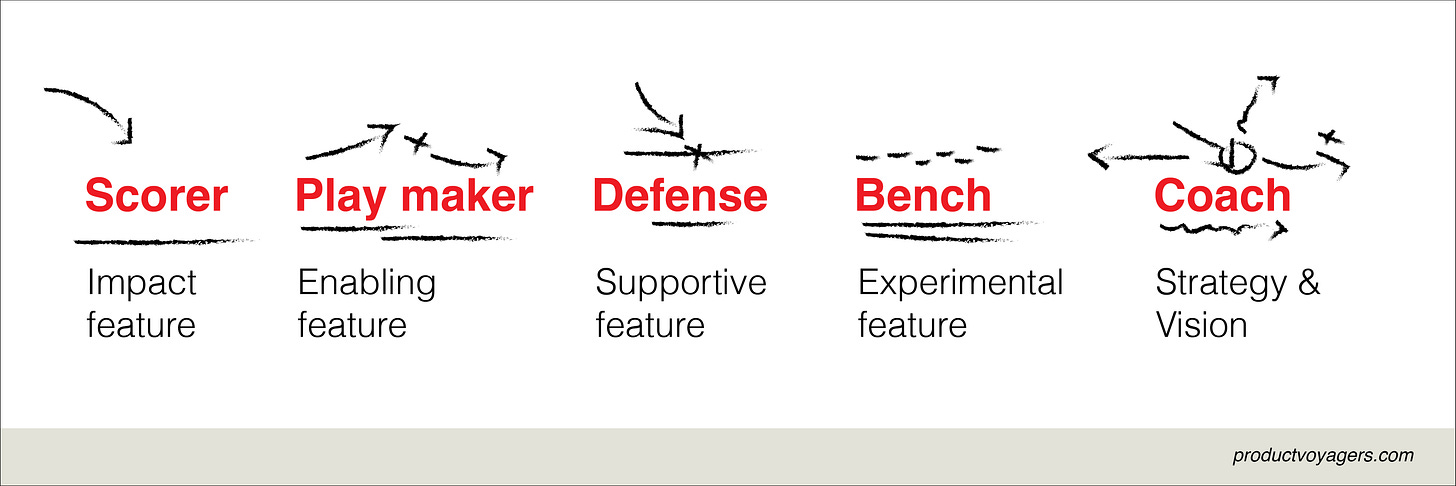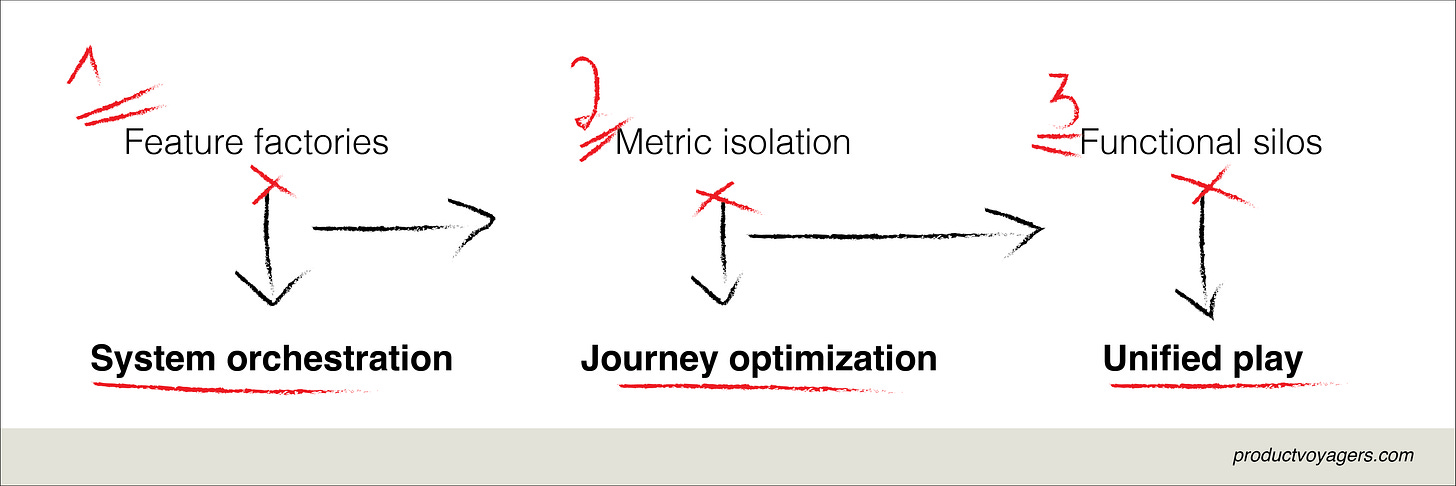The 'CHAMPIONSHIP' Product Manifesto
Why Everything You Know About Feature Development Is Obsolete!
"The strength of the team is each individual member. The strength of each member is the team." — Phil Jackson
Meet Nivin: A Voyager of Systematic Product Thinking
For over a decade, Nivin AL KUZBARI has been navigating the world of UX, product design, and digital strategy—crafting seamless experiences that don’t just function, but flow. She is UX leader with roots in graphic design, digital marketing, and user experience, and has seen firsthand how teams fall into the feature-first trap—and why the real game-changer is system thinking.
In her debut article for Product Voyagers, The Championship Product Manifesto, Nivin draws from sports dynasties and elite teams to reveal the missing piece in most product organizations. She makes a bold case: features don’t win markets—systems do.
🚀 It’s time to stop playing feature-by-feature and start orchestrating like champions.
🎤 Now over to Nivin 👇
THE MOMENT THAT CHANGED EVERYTHING
Western Conference Finals, 2019.
The Golden State Warriors—basketball's most dominant dynasty—faced elimination against Houston. Their unstoppable scorer Kevin Durant was injured. The basketball world had written them off.
At halftime of Game 6, their remaining superstar Steph Curry had scored exactly zero points.
What happened next wasn't just basketball. It was a masterclass in systems thinking that will forever change how you build products.
In the second half, the Warriors didn't just play basketball. They orchestrated a symphony where every player knew exactly what role to play at precisely the right moment. Curry erupted for 33 points. Draymond Green controlled the floor. Klay Thompson delivered in clutch moments. Role players made defensive stops that saved the game.
Without their MVP, the Warriors didn't just survive.
They transcended.
This transformation reveals the fundamental truth about great products that most teams never grasp:
Individual features, no matter how brilliant, will never create exceptional products. Only features that function as a unified system can deliver experiences that transform markets.
After a decade studying the world's most successful products and the teams that build them, I've discovered that this basketball metaphor isn't just a useful analogy.
It's the most accurate model for how breakthrough products actually emerge.
THE TRAGEDY OF FEATURE-FIRST THINKING
Walk into most product development organizations and you'll hear the same conversations:
"We need to improve conversion, so let's add this feature..." "Our competitor launched X, so we need to build Y..." "The data shows users want Z..."
These seemingly rational approaches share the same fatal flaw: they treat features as isolated solutions rather than interconnected components of a system.
The result?
Features that perform well in isolation but create friction in the actual user journey
Metrics that improve in the short term but create experience debt that erodes trust
Products that feel like assembled parts rather than cohesive experiences
In Fact: Your users never experience features. They experience systems. And when your system feels disconnected, they leave.
This is why so many product teams are trapped in a cycle of continuous iteration that never produces breakthrough results. They're optimizing parts while the system remains broken.
The Championship Product Framework changes everything.
THE BASKETBALL TEAM FRAMEWORK:
The 5 Roles That Create Championship Products
After analyzing how elite basketball teams and breakthrough products both operate as systems, I've identified five distinct roles that must be fulfilled for any product to achieve market dominance.
1. THE SCORER: VALUE-DELIVERING FEATURES
Product Example: Amazon's 1-Click Purchase
Basketball Parallel: Steph Curry's game-changing three-pointers
These features directly address the primary user need and deliver measurable value. They drive core metrics and get featured in marketing materials.
Why They're Not Enough: Scorers without support create "hero ball"—impressive moments surrounded by friction. Even Curry needed Thompson to draw defenders away and Green to get him the ball in the perfect position.
The Critical Mindset Shift: Stop asking "Will this feature drive conversion?" Start asking "How does this feature fit into the system that delivers value?"
2. THE PLAYMAKER: FLOW-ENABLING FEATURES
Product Example: Spotify's personalized discovery system
Basketball Parallel: Draymond Green's court vision and precision passing
These features create the conditions for value-delivering features to succeed. They handle transitions, maintain context, and ensure smooth handoffs between different parts of the experience.
Why They're Undervalued: Their impact is often indirect, making them difficult to justify in traditional ROI frameworks despite being the difference between clunky and smooth experiences.
The Critical Mindset Shift: Stop treating UX flow as a design concern. Start treating transitions between features as features themselves that require dedicated resources and ownership.
3. THE DEFENDER: TRUST-BUILDING FEATURES
Product Example: Gmail's "message recalled" feature
Basketball Parallel: Andre Iguodala's game-saving blocks and defensive positioning
These features prevent disasters, recover from errors, and build the trust foundation that allows users to engage confidently with value features.
Why They're Neglected: They don't drive growth metrics directly and often only get prioritized after a crisis has already damaged trust.
The Critical Mindset Shift: Stop viewing trust features as cost centers. Start measuring the "trust equity" they build as a tangible asset that enables your entire product system.
4. THE COACH: SYSTEM-ARCHITECTURE FEATURES
Product Example: Apple's ecosystem integration across devices
Basketball Parallel: Steve Kerr's motion offense system that maximized player strengths
These features create the underlying architecture that allows individual features to work as a unified system. They establish patterns, ensure consistency, and create the "team identity" users recognize.
Why They're Overlooked: They require cross-functional authority and long-term thinking that most product organizations aren't structured to support.
The Critical Mindset Shift: Stop treating product architecture as a technical concern. Start viewing it as the foundation that either enables or prevents breakthrough experiences.
5. THE SIXTH MAN: EXPERIMENTAL FEATURES
Product Example: Google's Labs experiments that become core features
Basketball Parallel: The bench player developing skills that transform next season's team
These features test potential new directions without disrupting the core experience. They create safe spaces for innovation while gathering real user feedback.
Why They're Misunderstood: Organizations either treat all features as experiments (creating incoherent experiences) or allow no experimentation (stagnating innovation).
The Critical Mindset Shift: Stop viewing experimentation as either "everything" or "nothing." Start creating intentional spaces for controlled innovation within your product system.
THE 3 MINDSET SHIFTS THAT TRANSFORM PRODUCT TEAMS
The Championship Product Framework isn't just about categorizing features. It fundamentally changes how teams think about product development.
1. FROM FEATURE FACTORIES TO SYSTEM ORCHESTRATION
The Old Mindset: "If we build enough good features, we'll have a good product."
The Championship Mindset: "Features are components of systems. The system's performance transcends the sum of its parts."
How It Changes Everything: Product teams stop optimizing for feature velocity and start optimizing for system coherence. The primary question shifts from "What features should we build next?" to "How do we evolve our product as an integrated system?"
2. FROM METRIC ISOLATION TO JOURNEY OPTIMIZATION
The Old Mindset: "Each feature should improve its primary metric."
The Championship Mindset: "Features serve the journey, not their individual metrics."
How It Changes Everything: Success metrics expand beyond conversion and engagement to include flow efficiency, error recovery, and system resilience. Teams measure how features impact the performance of adjacent features, not just their direct metrics.
3. FROM FUNCTIONAL SILOS TO UNIFIED PLAY
The Old Mindset: "Engineers build, designers design, product defines."
The Championship Mindset: "Everyone builds the system together with a shared understanding of how it works."
How It Changes Everything: Cross-functional collaboration moves beyond handoffs to true co-creation. Engineers participate in journey mapping. Designers influence technical architecture. Product managers facilitate system thinking rather than just prioritizing backlogs.
THE CHAMPIONSHIP PRODUCT PLAYBOOK:
5 Steps To Transform Your Approach
Here's how to immediately apply this framework to revolutionize your product development:
STEP #1: MAP YOUR PRODUCT AS A SYSTEM, NOT A FEATURE LIST
The Exercise: Create a visual representation of your product as an interconnected system, not a list of features. Map how features depend on and enhance each other.
Critical Questions:
What's the "starting lineup" of features that directly deliver core value?
What enabling features make those value-drivers successful?
Where are there gaps in your system where features are disconnected?
Which features are trying to play multiple positions and doing none well?
Transformation Trigger: Visualize user flows across features to reveal the crucial spaces between them that often create friction.
STEP #2: ASSIGN CLEAR ROLES TO EVERY FEATURE
The Exercise: For each feature, define its primary role in your product system—Scorer, Playmaker, Defender, Coach, or Sixth Man.
Critical Questions:
Is this feature primarily driving direct value or enabling other features?
Are we missing critical defensive features that protect user trust?
Do we have system-level features that create consistency?
Where have we miscast features in roles they weren't designed to play?
Transformation Trigger: Identify features trying to play multiple roles and refocus them on their core strength, then fill the gaps with purpose-built features.
STEP #3: REDESIGN YOUR PRODUCT DEVELOPMENT PROCESS AROUND SYSTEMS
The Exercise: Transform how features move from conception to delivery by embedding system thinking at every stage.
Critical Questions:
How does our roadmap planning account for system-level improvements?
Do our design reviews evaluate features in isolation or as part of the journey?
How do we measure the impact of features on adjacent features?
Does our organizational structure support system-level ownership?
Transformation Trigger: Create a "system impact assessment" for every new feature that maps its relationship to existing features.
STEP #4: CREATE A CONTINUOUS SYSTEM OPTIMIZATION PRACTICE
The Exercise: Establish regular cross-functional sessions focused exclusively on how features work together, not just how they perform individually.
Critical Questions:
Where are the most friction-filled transitions between features?
Which features are underperforming because adjacent features aren't supporting them?
What system-level patterns could eliminate redundancy across features?
How can we make defensive features more proactive than reactive?
Transformation Trigger: Appoint a "System Coach" responsible for identifying cross-feature opportunities that individual feature owners might miss.
STEP #5: REFRAME HOW YOU MEASURE SUCCESS
The Exercise: Develop a new dashboard that shows system performance, not just feature performance.
Critical Questions:
How efficiently do users flow through our entire system, not just individual features?
How effectively do we recover from errors across the journey?
How consistent is our user experience across the system?
What's our "assist rate"—how often do features successfully hand off to other features?
Transformation Trigger: Track the "system impact" of each feature launch by measuring changes in adjacent feature performance.
The Championship Product Mindset in Action
When the Warriors lost Kevin Durant, they didn't just plug in another scorer. They reimagined their entire system to create something that transcended individual talent.
This is exactly how breakthrough products emerge.
Apple didn't just build good devices—they created an ecosystem where each product enhances the others.
Spotify didn't just create a music player—they built a discovery system where recommendations, playlists, and listening habits reinforce each other.
Slack didn't just create messaging features—they orchestrated a communication environment where channels, threads, and integrations work in harmony.
The difference isn't that these companies build better individual features. It's that they think in systems, not features.
BEFORE I STEP AWAY:
This Is Your Transformation Moment
There comes a moment in the evolution of every product team when they make the critical shift from feature-focused to system-focused thinking.
This shift doesn't just change what they build. It transforms how they think.
Engineers stop asking "How do I build this feature?" and start asking "How does this feature fit into our system?"
Designers stop asking "How should this feature look?" and start asking "How does this feature create flow with adjacent features?"
Product managers stop asking "What features should we prioritize?" and start asking "How do we evolve our system to deliver more value?"
This moment—when a team starts thinking in systems rather than features—is when truly breakthrough products become possible.
Like the 2019 Warriors showed us: when individual excellence transforms into system brilliance, magic happens.
The Championship Product Framework isn't just a better way to build features.
It's a fundamental reimagining of what product development can be.
The question isn't whether you'll adopt this approach. The question is whether you'll do it before or after your competitors.
This framework embodies our 2025 commitment to operating like a championship sports team. By thinking beyond features and embracing system orchestration, we'll create products that don't just compete—they define categories.
🏆 Join the Championship Movement
Nivin's championship framework for product development seamlessly complements other insights in Product Voyagers, particularly the approach of unifying teams during discovery by embracing a holistic perspective. This systems-thinking mindset creates powerful connections across the entire product journey.
Product Discovery Redefined: Explore, Validate, Break
Years ago I was leading an initiative where we had every reason to believe we were on the right track. The team had done “discovery,” or so we thought: a few user interviews, a quick market analysis, and some internal brainstorming. But when we launched, the new feature didn’t resonate at all. I remember staring at the metrics in disbelief.
And at Product Voyagers, we're building a community of product leaders who are transforming how organizations think about product development.
🚀 Ready to elevate your product thinking? Whether you want to implement the framework, contribute your own insights, or simply explore new approaches, we'd love to hear from you.









